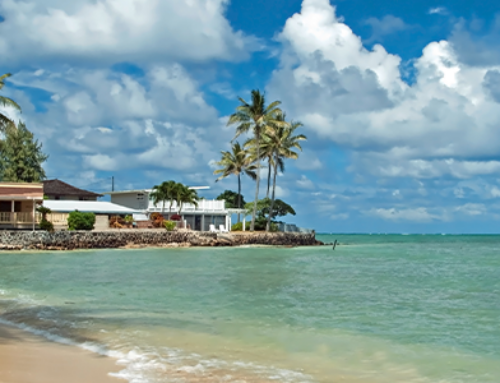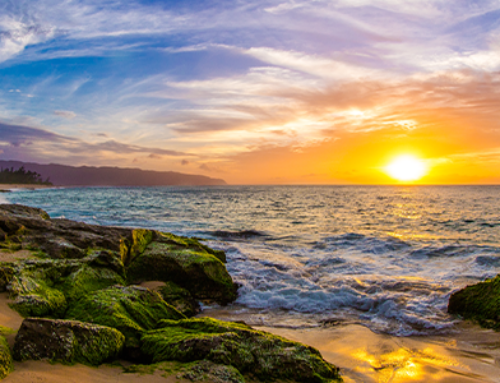You ask, and we answer! Every day, we speak with people who are considering a move to Hawaii. After nearly 40 years in the business, we’ve seen some patterns emerge.
Below, you’ll find our answers to the most pressing, most commonly asked questions about moving to (and living in!) Hawaii. We hope they help they give you some clarity on what to expect during and after your move to Hawaii—and deliver that final boost of confidence you need so you can commit to relocating to the Aloha State.
But before we begin, we’d like to address one more lingering question: What if my question isn’t answered here? We’ve got two options for further assistance:
- You may want to check out our Ultimate Guide to Moving to Hawaii, which will walk you through just about everything you need to know about moving to Hawaii.
- And, of course, our experts would be happy to talk with you. Just reach out to us with your questions, and we’ll be happy to get you the answers you need!
Now, let’s get started with the basics: making the move to Hawaii.
Your Top 6 Questions on Relocating to Hawaii
1. How much will it cost me to move my house/apartment/condo from the mainland U.S. to Hawaii?
You probably knew we were going to say this, but we’ll say it anyway: It depends.
After moving tens of thousands of families, individuals and service members between Hawaii and the mainland, we’ve discovered that the best way to get an accurate quote is to let us complete a complimentary survey of your belongings, either in-person or through a virtual walk-through. Online moving calculators, while convenient, generally don’t produce numbers that you can rely on—and budget for.
Now, if you’re curious exactly how our expert surveyors estimate the cost of your Hawaii move, we’re happy to walk you through the three factors that affect the price of your move. In addition to showing you the things that can make your move more expensive, our article will also offer you some tips on how you can save some money on your relocation.
2. What do I need to know to take my dog, cat, or other pet with me to Hawaii?
Bringing a pet with you to Hawaii is a little more complicated than, say, loading up your best buddy in a car and driving him or her from Oregon to Washington. Because the island is rabies-free—and home to a unique ecosystem—Hawaii has strict rules in place for bringing pets to the island.
This article will walk you through everything you need to know: The Complete Guide to Moving Your Dogs, Cats and Other Pets to Hawaii. It also includes links to the official forms and documentation you’ll need to provide so that your pet can make the move to Hawaii with you.
3. Is it easy to find pet-friendly rentals in Hawaii?
Pet-friendly rentals can be a bit of a challenge in Hawaii, especially if you’re moving to the island without an established network of friends or colleagues. Many landlords don’t allow pets at all. Others may only allow cats or dogs of a certain size. Additionally, if you have more than one pet, it can be challenging to find a landlord willing to consider your application.
You may have some luck searching Craigslist for pet-friendly rentals. You’ll likely be asked to pay a non-refundable deposit/fee, and you may also be asked to pay “pet rent” each month.
In our experience, once you get established in Hawaii and start to make friends, you’ll have a little better luck finding a place to rent, since some landlords will be more willing to bend their rules for people they know and trust.
4. What island should I live on?
This is one of the big ones we get all the time! If you’ve never visited Hawaii—or you’ve only visited one of the islands—you might not realize how different life can be on Oahu vs. the Big Island vs. Kauai vs. Maui. Which island you choose to live on will shape your Hawaii experience in a big way.
The best way to know for sure which island is right for you is to make a pre-move visit if you can. The next best way? Check out our article on which Hawaiian Island is right for you.
5. How much research should I do when choosing a neighborhood in Hawaii?
File this one under “questions you should ask when moving to Hawaii (even though a lot of people don’t).” If you haven’t spent a lot of time in the Hawaiian Islands, you might not fully grasp how diverse the ecosystems are within each island—and how big the islands can be. (More on that second half in a moment!)
On a typical day on the island of Maui, it might be raining in Haiku, cloudy in Kula, and blazingly hot and sunny in Kihei/Wailea—all at the same time. On the Big Island, the Hilo side is much wetter and cooler than the hot, dry Kona side. In other words, the weather can vary quite dramatically, depending on where you decide to live. Make sure you do your research so that the realities of your Hawaii life match up with your hopes and expectations.
6. What are the biggest surprises people get when moving to Hawaii?
Obviously, this will vary from person to person, depending on your experiences and your expectations. That said, we’ll name two big ones we’ve encountered over the years:
1. The islands are bigger than you think, and it takes time to get from one side to another. So, if you’re moving to Hawaii to fulfill your dream of surfing every morning, live as near your ideal break as possible, or resign yourself to a lot of driving.
2. The cost of living in Hawaii is high. A lot of people overlook this, and it’s worth a mention because, when it comes to this topic, it’s important to look at the big picture. For example, it’s not just that rent and groceries are expensive here. We have the highest electricity rates in the country. Residents have the second-highest tax burden in the U.S. And, finally, when we want to visit friends and family on the mainland, those plane tickets are rarely cheap (except when we get lucky!).
That said, is it worth it? In our opinion, YES! We absolutely love living in Hawaii and, everything we get to enjoy—the breathtaking landscape, the amazing weather, the aloha—makes it all worth it.
And while we’re talking about Hawaii life, let’s answer a few questions on that topic.
Your Top 6 Questions About the Logistics Around Living and Working in Hawaii
1. Is there a “rainy season” in Hawaii?
First of all, if you check out our answer to question #5 above, how much rain you see on a daily basis can vary drastically, depending on where you live.
However, the winter months (typically November–March) usually mean more rain in the Hawaiian Islands, although it varies from year to year.
2. Do I need a job before moving to Hawaii?
Moving with a job will help ensure a soft landing here in the Hawaiian Islands and allow you to get established more quickly. That said, we know plenty of people who arrived in Hawaii without a job and managed to find work (our very own General Manager of Freight & Trucking, Lee Ann Brusca is a great example)!
If you have a specialized skill—Lee Ann moved to Hawaii with 25+ years of logistics experience under her belt—you’ll likely find work faster. Alternatively, if you’re experienced in and comfortable with working in an area that supports tourism—such as hotels, restaurants, and retail establishments—you’ll likely find work more quickly.
All that said, it will be tough to find a job in Hawaii if you’re not physically here. Employers will want to meet you—and they’ll want to be sure that you’ll be physically here to take the job.
So if you’re not planning to bring your job with you and work remotely or applying for a transfer within your company, you’ll have better luck applying once you arrive.
Keep in mind, too, that Hawaii is a place where a lot of things happen through the people you know. This goes for things like jobs as well as places to live. So, once you arrive, stay friendly and get to know the people around you. You never know when one of those connections will turn into a new opportunity.
3. What’s the best way to find a place to live?
As with finding a job, it can be challenging to find a place to live in Hawaii when you’re not physically present on island. You may want to get a temporary rental for a week or two to get you started so you can apartment-hunt or house-hunt once you arrive.
To give yourself a head start, check out the apartment-hunting tips in this article. (And don’t miss the part about how to avoid some of the housing scams that pop up in Hawaii from time to time!)
4. Do I need a car in Hawaii?
If you plan to explore every inch of the island that’s available to you, you’re going to need a car. However, each island does have its own bus system, so if you want to see where you could go without a car, check out the system maps below:
- Oahu: TheBus
- Maui: Maui Bus
- Kauai: Kauai Bus
- Hawaii (Big) Island: Hele-On Bus
5. Should I ship my car? Or buy one once I arrive?
Ah, here’s another one of the big questions we get all the time. To help you decide whether it’s worth it to ship your car to Hawaii, check out this article: Shipping Your Car to Hawaii: Your Biggest Questions Answered.
6. Will my cell phone work in Hawaii?
In general, yes. AT&T, Sprint, T-Mobile, and Verizon phones all work in Hawaii. Of course, your mileage will vary depending on your carrier and your location.
If you have specific questions about coverage on your chosen island, check out the carriers’ coverage maps:
Now that we’ve covered the logistics, let’s talk about the fun stuff: island life and culture!
Your Top 6 Questions about Island Life & Culture
1. What’s the best way to meet people in Hawaii?
You’ll likely naturally meet people through work or, if you have children, through the school community. However, when it comes to expanding your social circle, our advice is to get involved with the things you love. Whether it’s beach volleyball, canoeing, scuba diving, hiking, or any number of the things you can get into on Hawaii, there’s likely an organization, a Facebook Group, or a Meetup Group who’s organizing activities. Do a little online research, and you’ll likely find a group adventure you can join, one that will help you start to widen your group of friends.
2. What’s the right way to pronounce the Hawaiian words I’ll encounter?
Practice! Although they may look challenging at first (humuhumunukunukuapuaa, anyone?), many of the place names, street names, and historical figures’ names will soon become familiar and start to roll off your tongue, especially when you start to break them down a little (humu-humu-nuku-nuku-apua-a).
The Hawaii Tourism Authority has a great guide to get you started, and you may also find this Hawaiian dictionary helpful for building your vocabulary. Additionally, you’ll also find it helpful to understand the role that the okina plays in the Hawaiian language. In addition to changing the pronunciation, it also can change the meaning.
3. How bad is the traffic on Oahu really?
Although Honolulu made headlines in 2012 when the city was ranked as the #1 worst city for traffic in the U.S., it’s now dropped to a moderate 18th place on the worst list.
However, there is a trick: Avoiding Honolulu traffic is all about understanding where the bottlenecks are. If you try to go west on the H1 during afternoon rush hour, you’re going to get stuck. If there’s any way you can avoid going into town in the morning hours or heading out of town in the afternoon hours, you’ll skip the majority of the traffic.
4. Are there a lot of bugs in Hawaii?
Like many other warm and humid parts of the United States, Hawaii has its share of bugs. Rare, out-of-control infestations aside, we wouldn’t say the bug situation is any more significant here than it is in Florida.
There are two insects in Hawaii that tend to make newcomers nervous:
- Centipedes – While not poisonous, these insects can deliver a painful bite.
- Flying Cockroaches – Yes, they fly—and often straight at you.
As on the mainland, you’ll want to manage bug populations by keeping your place clean and calling in the pros if the situation starts to get out of control. On a day-to-day basis, we recommend:
- Keeping your counters wiped and your sinks clear of dirty dishes that may attract insects.
- Storing staples like flour and sugar in airtight containers or Ziplock bags (or in the fridge!).
- Managing occasional sugar ant outbreaks with liquid ant baits. They work like a charm!
5. Do people really get “island fever?”
We’re not sure there’s an official diagnosis, but there is a kind of longing that can build up when you spend a lot of time on the same island, one that compels you to see new sights, eat new dishes, and explore new landscapes.
However, in our experience, there are two things that keep island fever at bay:
- Get out of “your side” of the island. It’s easy to fall into a rut, even on a small island in the middle of the Pacific. Hop in your car and drive to the other side of the island for happy hour at a new spot. Organize an outing to sit on one of the beaches you never go to. It’s easy to overlook all the awesome sights in your backyard, but making use of them can quickly reduce island fever.
- Hop an interisland flight. With Southwest in the game, you’ve got even more options for a weekend of island hopping. Trade Kauai for the Big Island for a few days, and you’ll quickly fill the well with new sights, tastes, and experiences.
Have More Questions?
Now that we’ve covered the biggest questions we get about relocating to Hawaii, we hope we’ve given you a sense of what it’s like to move to (and live in!) the Hawaiian Islands. With all this information in hand, perhaps you’ll also find yourself one step closer to deciding that the Aloha State is a place that you’d like to call home.
_____
If you still have more questions, we’d be happy to help! Don’t forget to check out our Ultimate Guide to Moving to Hawaii—or reach out to us. One of our experts will help you get all the answers you need!
Tell us about your move!



